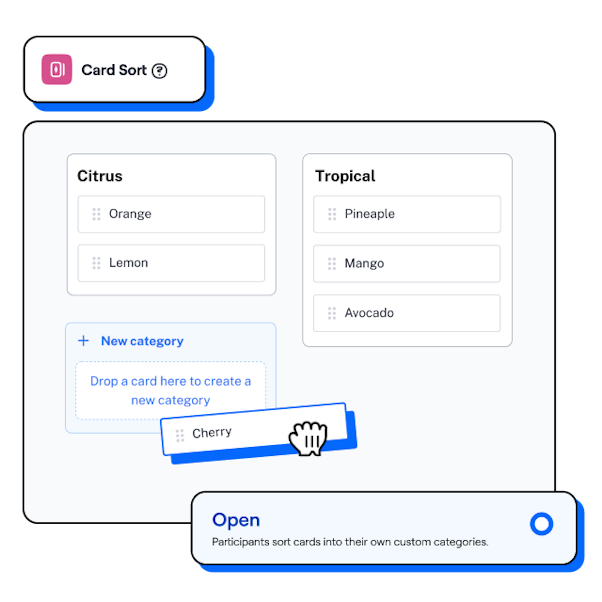Chapter 4
8 Card sorting tools to understand how users organize content
It’s easier than ever to conduct a remote card sorting study, with endless digital tools to choose from. To help make this decision, this final chapter will reveal our top picks for digital card sorting tools to make your UX research easier and more impactful.
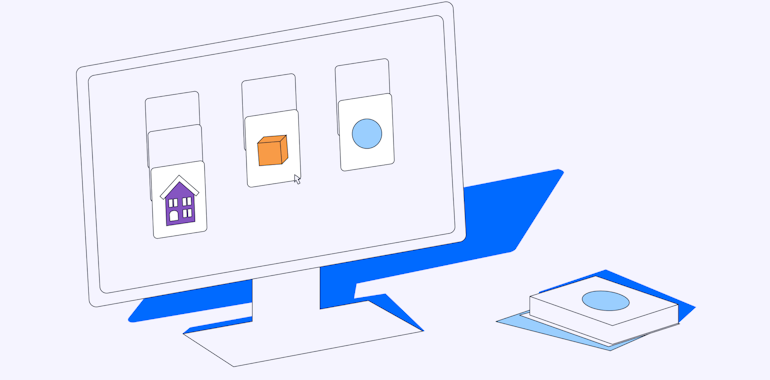
TL;DR
- Card sorting helps you see how users naturally group and label content, making it one of the quickest ways to fix confusing navigation and validate IA early.
- Open, closed, and hybrid sorts answer different questions: explore mental models, validate proposed structures, or do both while iterating.
- Maze is the best value and most complete solution for continuous card sorting, offering fast setup, templates, visual calculation, AI summaries, and easy sharing. It’s ideal for teams that want continuous, research evidence-driven IA decisions. Other options include OptimalSort, kardSort, UXtweak, Useberry, and more.
Why card sorting matters in UX research
Card sorting helps you see how users expect information to be grouped. It shows the mental models they adhere to when using your product, so you can structure content in a way that feels familiar instead of confusing—thus improving their experience using your product.
This research method highlights unclear labelling, misplaced information, and unintuitive categorization that doesn’t match how people think. The results obtained from card sorting tests shape early decisions, and tell you how navigable your information architecture is and what needs fixing before you invest in further product development.
Remote card sorting also scales well. You can test with a large number of participants, run unmoderated sessions for speed, and analyze patterns without dealing with physical cards or manual cleanup.

Meet Maze's card sorting analysis report
8 Best card sorting tools for UX research
Choosing the right online tool for any kind of UX research is a precarious notion. How can you possibly know what software will best serve your needs, and reveal your users’ needs? To make your job simpler, we’ve compiled a list of our top card sorting tools for UX research.
Before comparing tools, it helps to understand the three types of card sorting most platforms support:
- Open card sorting: Participants create and name their own groups. Useful when you want to uncover mental models and see how people naturally organize content.
- Closed card sorting: Participants sort cards into predefined categories. Ideal for validating an existing IA or testing a proposed structure.
- Hybrid card sorting: A mix of both. Participants use your categories but can add new ones if something doesn’t fit. Helpful when iterating on a structure that’s mostly defined but still flexible.
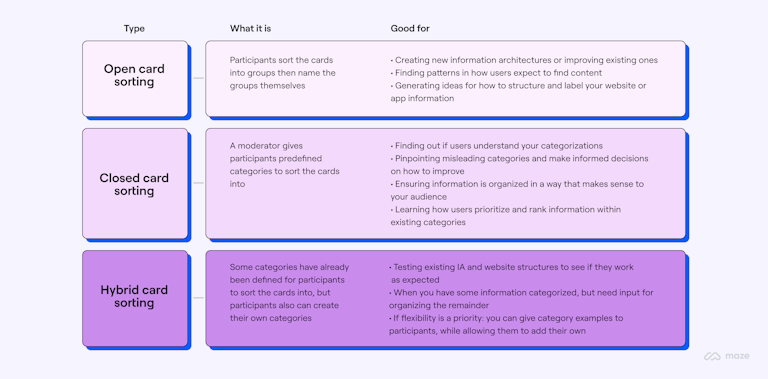
Card sorting type comparison table
While every researcher has their own preferences on card sorting tools, there are three key areas that will be affected by your choice of tool:
- The ease with which the card sort is set up
- The experience of users while participating in the study
- The reporting and analytic capabilities when reviewing results
Maze | UserTesting | Miro | Optimal Workshop | UX Metrics | KardSort | UXtweak | Useberry | |
|---|---|---|---|---|---|---|---|---|
Closed card sorting | ✅ | ✅ | ✅ | ✅ | ✅ | ✅ | ✅ | ✅ |
Open card sorting | ✅ | ✅ | ✅ | ✅ | ✅ | ✅ | ✅ | ✅ |
Hybrid card sorting | ❌ | ✅ | ✅ | ❌ | ✅ | ✅ | ✅ | ❌ |
Moderated studies | ✅ | ✅ | ✅ | ❌ | ❌ | ❌ | ✅ | ❌ |
Unmoderated studies | ✅ | ✅ | ❌ | ✅ | ✅ | ✅ | ✅ | ✅ |
Images supported | ✅ | ✅ | ✅ | ❌ | ❌ | ❌ | ✅ | ✅ |
Participant panel | ✅ | ✅ | ❌ | ✅ | ❌ | ❌ | ✅ | ✅ |
Recruit own users | ✅ | ✅ | ❌ | ✅ | ✅ | ✅ | ✅ | ✅ |
Automated reports | ✅ | ❌ | ❌ | ❌ | ❌ | ❌ | ❌ | ✅ |
Additional research methods | ✅ | ✅ | ❌ | ✅ | ❌ | ❌ | ✅ | ✅ |
1. Maze

Maze
Maze is a continuous product discovery platform that empowers Product teams to collect and consume user insights continuously. With card sorting from Maze, you can run open or closed card sorting tasks, set your own instructions, and customize each card with images or descriptions.
Participants sort cards through an intuitive drag-and-drop interface, and Maze turns their actions into instant analytics with agreement rates, auto-grouped categories, a similarity matrix, and an agreement matrix that show exactly where users align or diverge.
Your results feed into a ready-made card sorting report that highlights high-agreement categories, popular cards, and one-off outliers so that teams can update naming, navigation, and IA with confidence.
Maze also includes purpose-built templates so you can roll out UX/UI that helps users achieve objectives and delight in design.
Maze’s complete card sorting solution allows you to:
- Elevate how you name products, features, and settings with your target audience
- Craft navigation and product architecture based on your user mental models to improve user experience
- Bring users into your decision-making process early to pre-empt and avoid unnecessary reworks and make UX your competitive edge
- Speed up your time to valuable insight with automated analytics like auto-grouping and matrix visualizations for your results
- Create an intuitive card sorting session, with detailed card customization, including in-card images
- Highlight information in your Maze Report and prioritize key findings: Popular categories, Top cards, One-off categories, and One-off cards
- Recruit card sorting participants directly through the tool, speeding up your research process
Type of card sort: Open, closed
Works on: Browsers
Pricing: Maze offers a free plan and custom Enterprise plans
Maze does more than just card sorting. Run website tests, prototype tests, moderated interviews, surveys, tree testing, and more with Maze’s comprehensive suite of user research and testing methods. Recruit research participants with ease and increase efficiency across the research process with AI-powered capabilities.
2. UserTesting
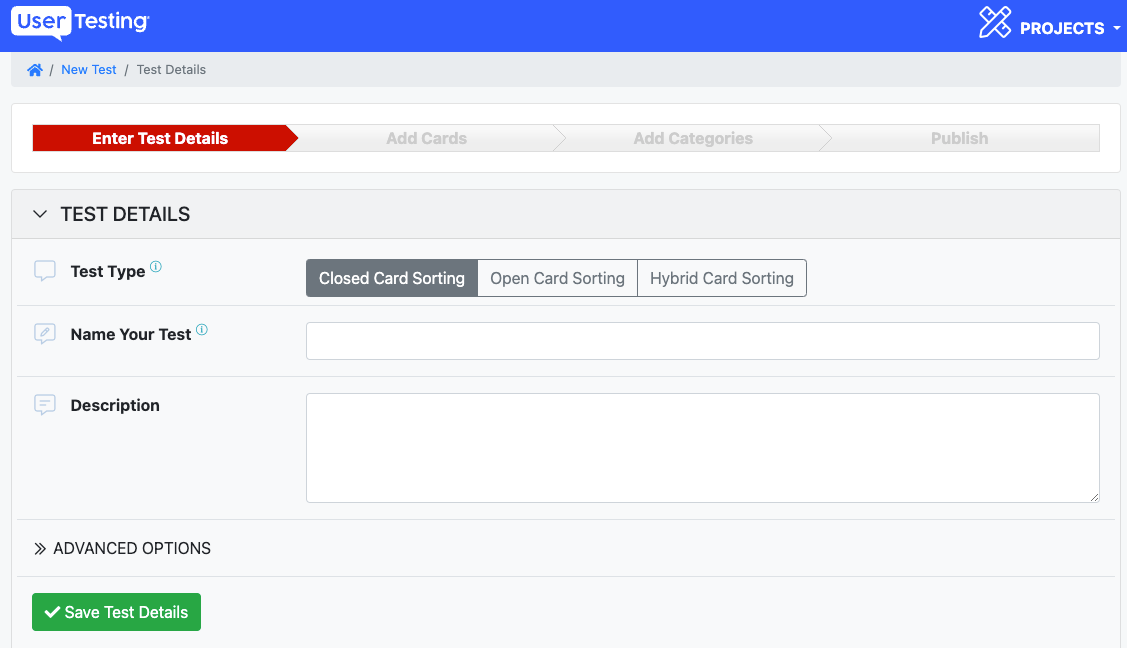
UserTesting
UserTesting supports open, closed, and hybrid card sorts, but only as part of a think-aloud website test, which means teams often need to work around the tool’s setup rather than use a purpose-built card sorting flow.
However, if you want to upload images or use more advanced setup options, UserTesting pushes you into a separate ‘classic’ card sorting tool. This is an older, standalone interface outside the main platform where you have to rebuild your cards and categories from scratch, publish the activity, and then paste a link back into your test plan.
Analysis is fully manual; there’s no agreement rate, no auto-grouping, no clustering matrices, and no automated reporting. Card sorting is only available on higher-tier plans, making it harder for teams to use it as a fast, scalable IA testing method.
Type of card sort: Open, closed, hybrid
Works on: Browsers
Pricing: UserTesting doesn’t list pricing models publicly, but offers three plans to choose from: Advanced, Ultimate, and Ultimate+
3. Miro
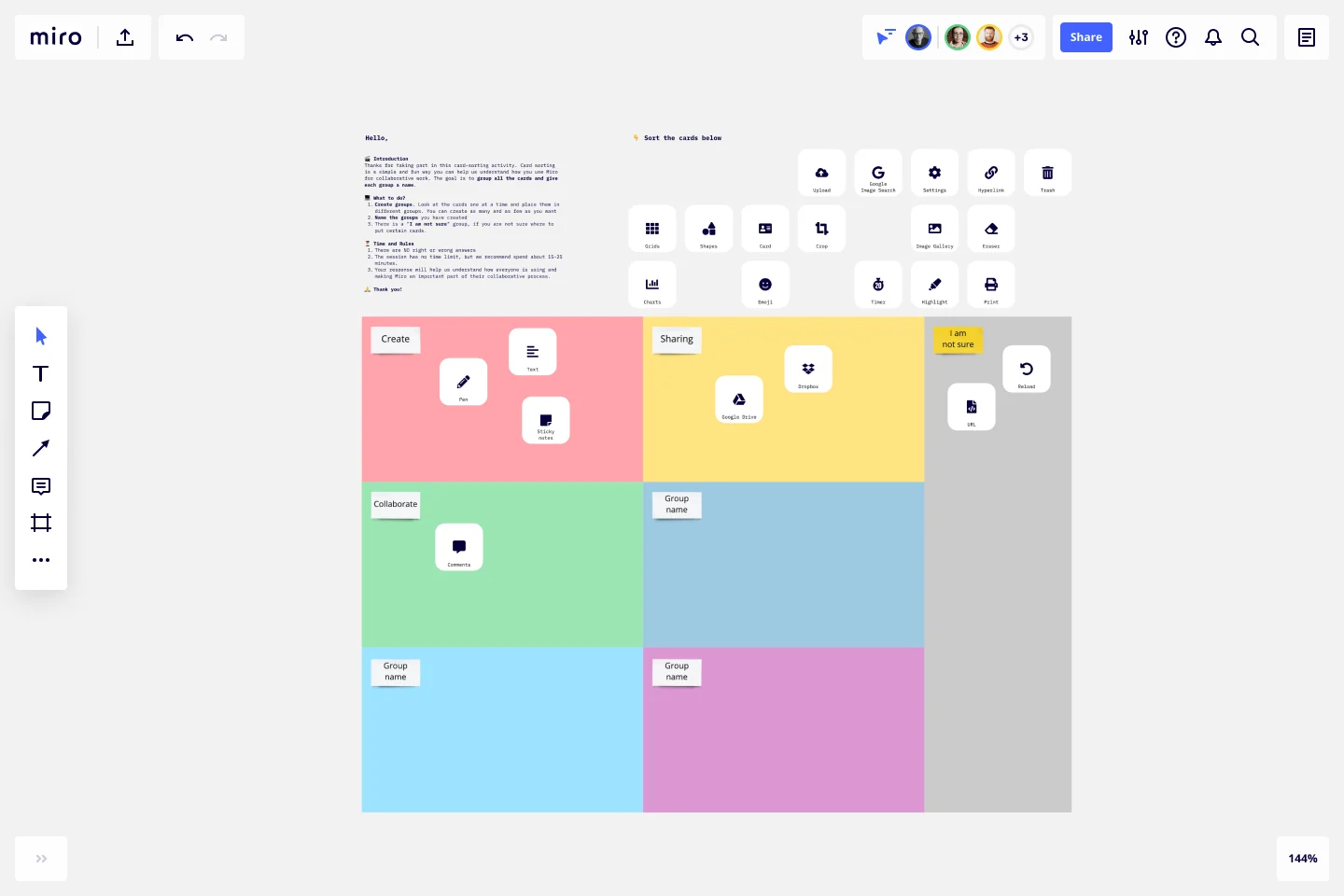
Miro
Miro is a tool that we all know and love—the ‘online whiteboard’ built for collaboration is a platform with endless uses, including card sorting.
The beauty of Miro is that it’s a simple concept with the capabilities of a complex, digital tool. This is what makes it great for card sorting. A whiteboard is often a UX researcher’s starting point for an in-person card sorting session, and Miro simply takes this online. The platform combines an intelligent infinite canvas with structured formats like Docs, Tables, Slides, and Diagrams, so teams can brainstorm, plan, and build in one place.
The big downside to Miro as a card sorting system is that it doesn’t offer any post-study analytics, so it’s on you to get analyzing. That being said, if you’re looking for as close to an in-person card sort as possible, Miro’s the tool for you.
Type of card sort: Open, closed, hybrid
Works on: Browsers, Mac, Windows, Android, iOS
Pricing: Miro is free for up to three boards, with paid plans starting at $8 per user/month
4. OptimalSort
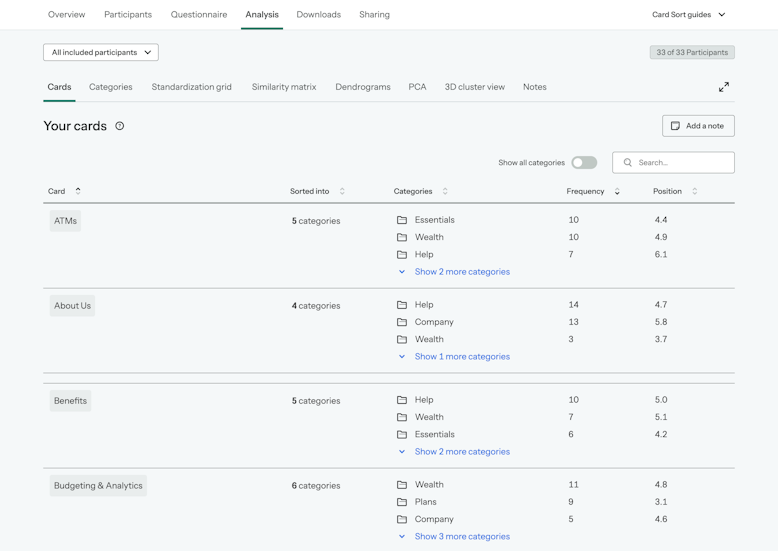
OptimalSort
OptimalSort is Optimal Workshop’s card sorting solution. It helps teams understand how users naturally group information, with automated analyses and session replays. It’s a great tool for validating navigation, organizing large content sets, and uncovering users’ mental models across websites, apps, knowledge bases, and product catalogs.
The main limitations are that OptimalSort doesn’t offer hybrid card sorting or image-based cards, and its information architecture analysis is pretty basic. Card sorting is also unmoderated only, so teams rely on session replays rather than running live or guided sessions.
Type of card sort: Open, closed
Works on: Browsers, Mac, Windows
Pricing: OptimalSort starts at $199/month (billed annually) for 5 studies, unlimited seats, and unlimited participant responses per study
5. UXMetrics
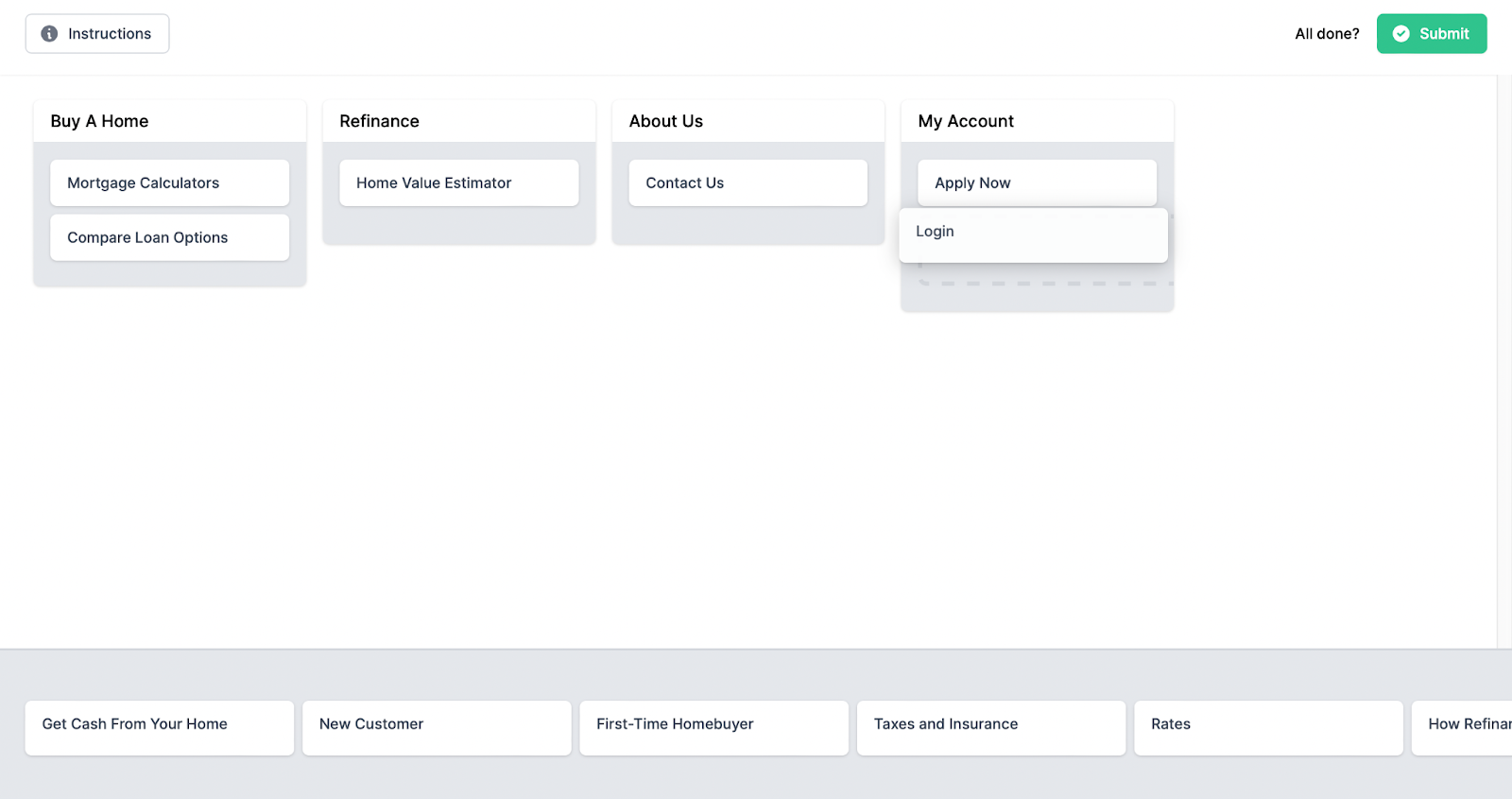
UXMetrics
UXMetrics offers open, closed, and hybrid card sorting that works smoothly on any device. Studies can be launched in minutes using a shareable link, and the tool generates instant analysis with agreement scores, frequency rankings, and participant-level data.
However, you need to upgrade to the paid plans for add-ons to randomize card order, apply custom branding, password-protect reports, issue completion codes to verify unmoderated sessions, merge similar groups, and export all data to XLS.
UXMetrics also lacks a built-in participant panel, session recordings, or live moderated sorting, which means it’s only a card sorting solution rather than a full research ecosystem.
Type of card sort: Open, closed, hybrid
Works on: Browsers
Pricing: UXMetrics is free for three participant results, with paid plans starting at $49/month
6. kardSort
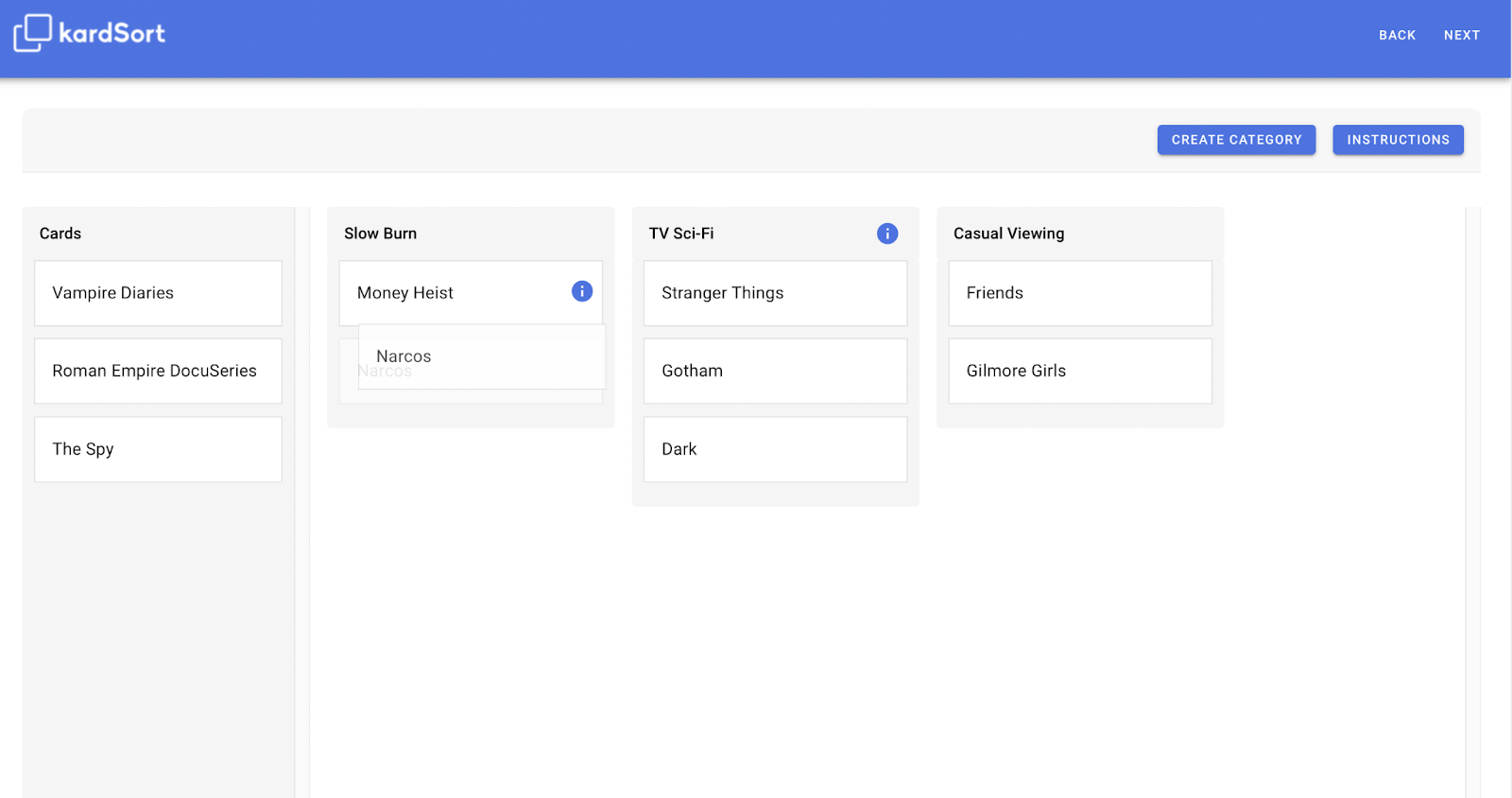
KardSort
kardSort is a free card sorting option that offers simple drag-and-drop card sorting, like many of the tools on this list. It gives you the essential output formats, CSV, SynCaps V3, and Casolysis, so you can run your analysis in Excel, R, or external UX tools. Studies can be lightly customized with password protection, start/end scheduling, and optional pre- or post-questionnaires.
However, kardSort doesn’t include dashboards, automated clustering, participant recruitment, or additional research capabilities like tree testing or session replays, so you won’t get built-in reporting or deeper analysis beyond raw outputs.
Type of card sort: Open, closed, hybrid
Works on: Browsers
Pricing: Offers a free plan, and paid plans start from €11/month plan (≈ about $12–$13/month USD) for 5 studies, 30 questions, and 100 participants
7. UXtweak
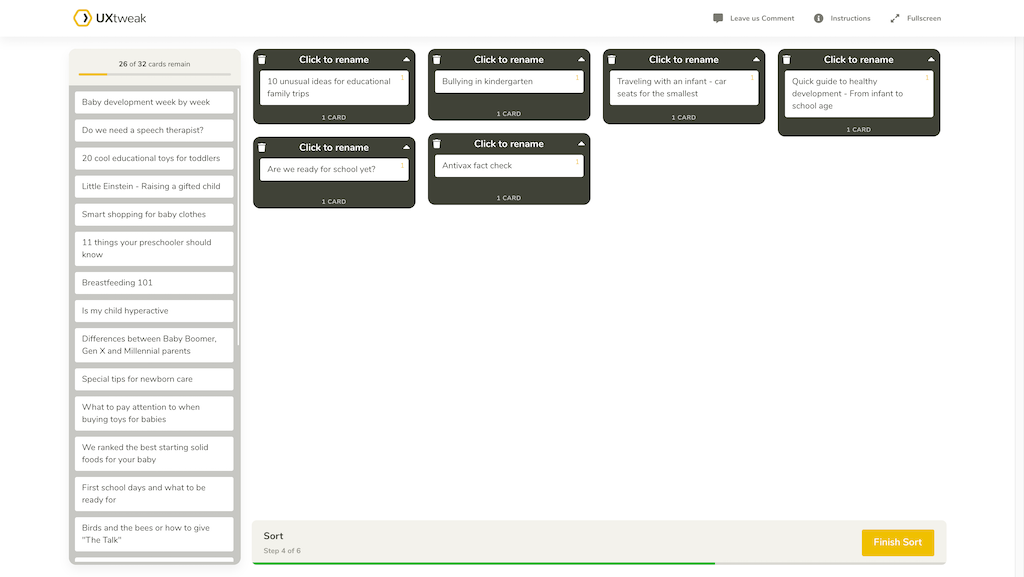
UXtweak
UXtweak, like many others on this list, allows for closed, open, and hybrid card sorting. With lots of customization options, UXtweak, alongside Maze, is one of just a few card sorting tools that feature card configurations—like images on cards—opening up a whole realm of card sorting possibilities.
UXtweak provides researchers with downloadable reports that include a variety of data visualization tools, like a similarity matrix and dendrograms.
However, it still lacks a few capabilities that advanced IA or enterprise research teams may expect. You can’t create nested hierarchies during sorting, which means multi-level taxonomies must be validated separately through tree testing.
Type of card sort: Open, closed, hybrid
Works on: Browsers
Pricing: Free for one live study and user, with paid plans starting at €125 per user license/month
8. Useberry
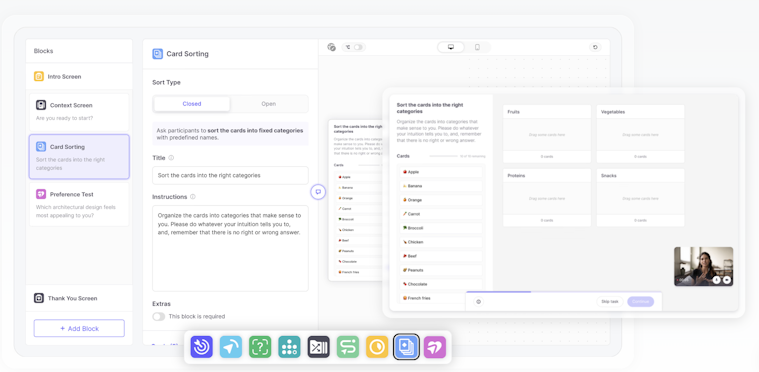
Useberry
Useberry’s card sorting tool supports open and closed studies with a flexible setup that lets you bulk-add cards, use images or tooltips, randomize order, and give participants clear instructions. Reports include card and category level views, matrix analysis, and a similarity matrix for open sorts.
However, Useberry’s information architecture analytics lack advanced techniques, like dendrograms or automated clustering. Open sorting also requires manual category standardization before you can aggregate insights.
Type of card sort: Open and closed
Works on: Browser
Pricing: The free plan includes only one user, and the paid plans start at $79/month for one seat and 300 responses/month
How to choose the best card sorting tool for your team
Choosing a card sorting tool comes down to your workflow: the type of sort you need to run, how deeply you plan to analyze the results, and how quickly you want to move from setup to insight.
Consider these criteria to evaluate which tool fits your team’s research practice.
Support for card descriptions and context
You need a tool that handles unclear or technical labels by allowing images, descriptions, or tooltips. Maze, UXtweak, and Useberry all allow you to add this context directly on the card, which helps participants understand what they’re sorting instead of guessing from an unclear label.
Depth of analysis and reporting
If you’re making decisions beyond a simple IA check, look for tools that offer similarity matrices, agreement scores, and dendrograms. Maze and UXtweak provide deeper analysis, while UXMetrics, kardSort, and OptimalSort are better suited to quick, lightweight studies.
Study setup speed
If card sorting exercises are a part of your regular UX research methods, you want a tool that lets you define cards, choose the sorting type, and share the link in minutes. For example, Maze’s template library gives you a head start for common IA tasks like menu reviews, content grouping, or navigation tests, so you can skip repetitive configuration and get a study live faster. UXtweak and OptimalSort also offer templates that reduce manual configuration and help teams launch studies faster.
Integration with your research workflows
Card sorting feeds into larger IA and usability processes. If you create wireframes and prototypes with design tools, you want a tool that can connect seamlessly. Maze integrates with Figma and Axure, and even supports AI-generated prototypes from Figma Make, Bolt, and Loveable, so you can move from exploration to validation in one place. If you need a whiteboard layer for workshops, Miro connects well with broader collaboration workflows, even though it doesn’t have a bespoke offer card sorting solution.
Pre- and post-study questions
A screener helps ensure only the right participants take part, and follow-up questions explain why they grouped or labeled items a certain way. If you rely on this type of qualitative context, choose a tool that supports simple surveys or branching logic around the sort. Maze helps with pre or post-questionnaires, conditional logic and more detailed participant metadata as compared to UXtweak, OptimalSort, and kardSort.
Value and free trial options
For teams who run multiple card sorts a year, the real question is: “What do we actually get for the price?”
Free trials are useful for testing usability and workflow fit, but long-term value depends on factors like analytical depth, study limits, integrations, participant workflows, and how much manual work the tool removes from your process.
Look for pricing that scales with your research practice, especially if card sorting is part of a larger IA or continuous discovery program. Maze is built for growing teams that want to check new IA ideas every few releases, validate a navigation restructure, or run early explorations.
You lead the research, Maze helps you get more value out of it.
Get real, actionable card sorting insights
Maze's card sorting offering enables valuable access on how your users organize and categorize information.
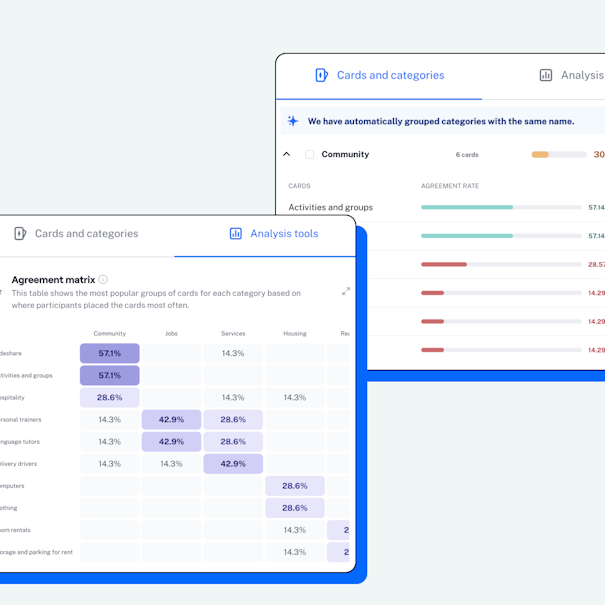
Frequently asked questions about card sorting tools
What is a card sorting tool?
What is a card sorting tool?
A card sorting tool is a digital platform or software that UX researchers use to conduct card sorting studies. Some of our recommendations for card sorting tools include Maze, UserTesting, Miro, OptimalSort, UXMetrics, kardSort, UXtweak, and Useberry.
How do card sorting tools help improve information architecture?
How do card sorting tools help improve information architecture?
Card sorting tools help improve information architecture by enabling research teams to identify how users naturally group and label content. They help spot unclear categories, fix confusing labels, and structure menus in a way that matches user expectations. By testing navigability early, you can build an information architecture that’s more intuitive and in line with user expectations.
What is important to look for in a card sorting tool?
What is important to look for in a card sorting tool?
Look for a card sorting tool that offers quick setup, support for open/closed/hybrid sorts, a smooth participant experience, and clear reporting you can act on without manual cleanup. Recruitment options, pricing, and the ability to analyze patterns (like similarity or agreement) also matter if you’re using card sorting regularly.
How does Maze’s card sorting solution stack against others?
How does Maze’s card sorting solution stack against others?
Maze offers one of the most complete card sorting workflows in the user research space. The platform supports open and closed sorts, includes card-level customization (like images), and provides automated themes, visual analytics, and AI summaries that cut analysis time dramatically.
Unlike most tools, Maze also includes ready-made templates, participant recruitment, and fast sharing through auto-generated reports. Maze offers a Free forever plan for solo researchers or small teams, and custom Enterprise pricing for larger teams with greater research needs.



